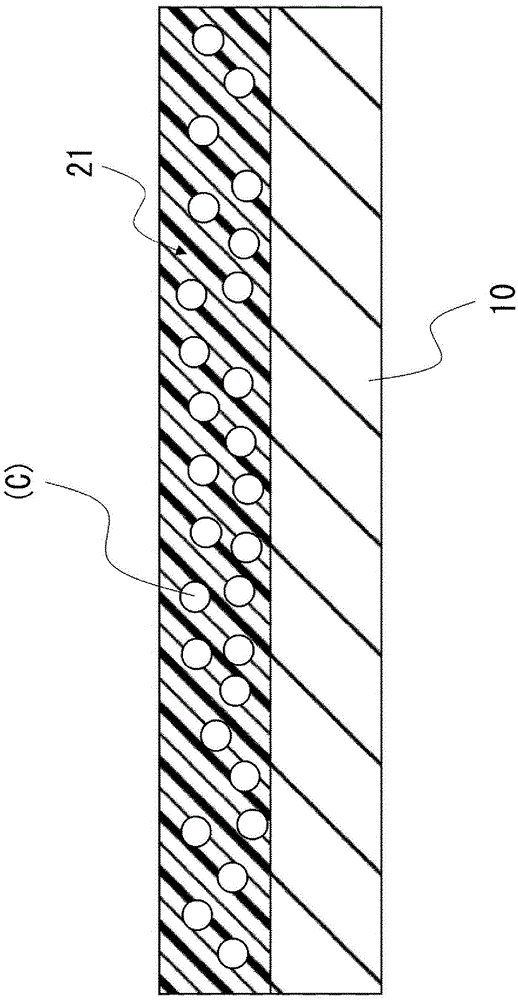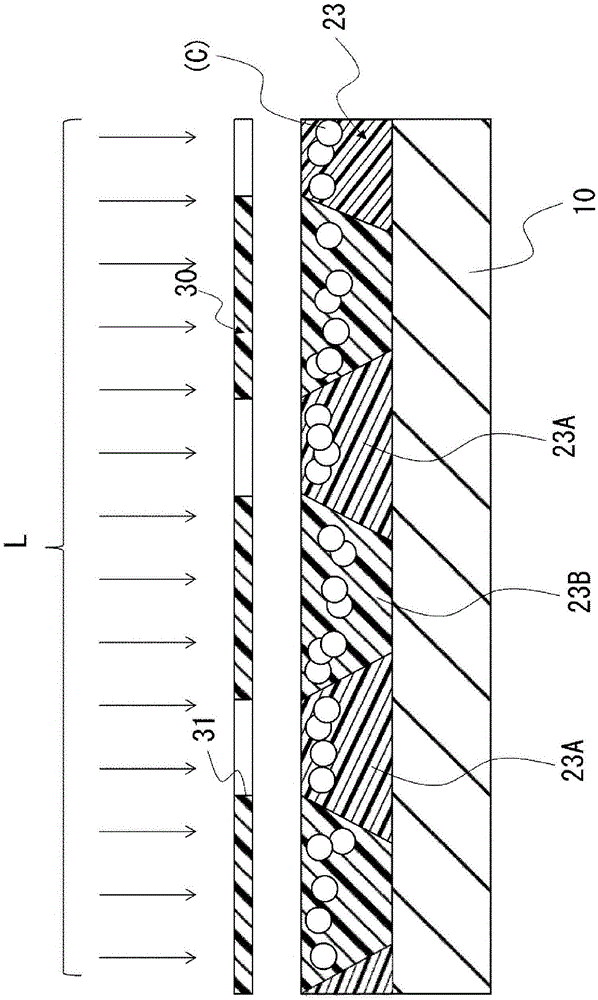Partially hydrolyzed condensate, ink repellent, negative photosensitive resin composition, cured film, partition wall and optical element
A technology of hydrolyzing condensate and dividing wall, applied in the field of optical components, can solve the problems of easy deterioration of organic layers such as light-emitting layers
- Summary
- Abstract
- Description
- Claims
- Application Information
AI Technical Summary
Problems solved by technology
Method used
Image
Examples
Embodiment
[0401] Hereinafter, the present invention will be described in more detail using examples, but the present invention is not limited to these examples. In addition, Examples 1-9 and Examples 11-19 are examples, and Examples 10 and 20 are comparative examples.
[0402] Each measurement was performed by the following method.
[0403] [Number average molecular weight (Mn) and mass average molecular weight (Mw)]
[0404] Using a commercially available GPC measuring device (manufactured by Tosoh Corporation, device name: HLC-8320GPC), as a standard sample for molecular weight measurement, commercially available multiple monodisperse polystyrene polymers with different degrees of polymerization were measured for coagulation. Gel Permeation Chromatography (GPC). A standard curve was prepared based on the relationship between the molecular weight of polystyrene and the retention time.
[0405]After each sample was diluted to 1.0% by mass with tetrahydrofuran and passed through a 0.5...
example 1
[0442] [Example 1: Preparation of ink repellent agent (C1) liquid]
[0443] At 1,000cm equipped with a mixer 3 32.3 g of the compound (c-11) and 67.7 g of the compound (c-21) were charged in a three-necked flask of the same, to obtain a hydrolyzable silane compound mixture. Next, 569.4 g of PGME was added to this mixture to prepare a raw material solution.
[0444] 44.7 g of 0.1 mass % hydrochloric acid aqueous solution was dripped at the obtained raw material solution. After completion|finish of dripping, it stirred at 40 degreeC for 5 hours, and obtained the PGME solution (ink repellent agent (C1) concentration: 10 mass %) of the ink repellent agent (C1). Hereinafter, this solution is called (C1) liquid.
[0445] In addition, after completion|finish of reaction, the reaction liquid was measured using gas chromatography, and it confirmed that each compound used as a raw material was below the detection limit.
[0446] Table 1 shows the composition (mol %) of the feed amou...
example 2~10
[0447] [Examples 2-10: Preparation of Ink Repellent Agents (C2)-(C9) and (H1) Liquid]
[0448] The feeding amount composition (mol %) and the kind of solvent of the ink repellent are set as shown in Table 1, except that, operate in the same way as Example 1, and obtain the ink repellent (C2)~(C9), and (H1 ) solution (ink repellent agent concentration: 10% by mass). Hereinafter, each solution is called (C2)-(C9), (H1) liquid.
[0449] In addition, in Example 10, the ink repellent agent (H1) liquid was prepared without using a compound (c-2). Since this ink repellent is not the ink repellent (C) of this invention, the sign of the ink repellent was changed. All the ink repellent agents for comparison were made into (H), and the ink repellent agent of Example 10 was made into (H1).
[0450] (evaluate)
[0451] The following evaluation was performed about the ink repellent agent obtained in Examples 1-10.
[0452]
[0453] About each ink repellent agent obtained in Examples ...
PUM
| Property | Measurement | Unit |
|---|---|---|
| thickness | aaaaa | aaaaa |
| acid value | aaaaa | aaaaa |
Abstract
Description
Claims
Application Information
 Login to View More
Login to View More - R&D
- Intellectual Property
- Life Sciences
- Materials
- Tech Scout
- Unparalleled Data Quality
- Higher Quality Content
- 60% Fewer Hallucinations
Browse by: Latest US Patents, China's latest patents, Technical Efficacy Thesaurus, Application Domain, Technology Topic, Popular Technical Reports.
© 2025 PatSnap. All rights reserved.Legal|Privacy policy|Modern Slavery Act Transparency Statement|Sitemap|About US| Contact US: help@patsnap.com



